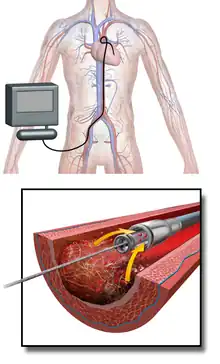Embolectomy
| Embolectomy | |
|---|---|
| Specialty | vascular surgery |
| ICD-9-CM | 39.74, 38.0, 38.1 |
| MeSH | D017128 |
Embolectomy is the emergency surgical removal of emboli which are blocking blood circulation. It usually involves removal of thrombi (blood clots), and is then referred to as thrombectomy. Embolectomy is an emergency procedure often as the last resort because permanent occlusion of a significant blood flow to an organ leads to necrosis. Other involved therapeutic options are anticoagulation and thrombolysis.
Medical uses
Surgical embolectomy for massive pulmonary embolism (PE) has become a rare procedure and is often viewed as a last resort. Thrombolytic therapy has become the treatment of choice.[1]
Surgical or catheter embolectomy is normally performed in patients with pulmonary embolism (formed from venous embolisms). Embolectomy is used for patients with persisting shock despite supportive care and who have an absolute contraindication for thrombolytic therapy.[2] And although other treatments have improved urgent surgical embolectomy or catheter embolectomy may be a life saving procedure in severe pulmonary embolism.[3]
Embolectomies are performed as limb-sparing techniques for arterial embolisms in acute limb ischemia. However, there are also other options, such as catheter-directed thrombolysis and anticoagulation with observation.[4]It can also be used for other ischemias due to embolism for example mesenteric ischemia and stroke.[5][6]
Methods

Catheter embolectomy
Balloon embolectomy
Typically this is done by inserting a catheter with an inflatable balloon attached to its tip into an artery, passing the catheter tip beyond the clot, inflating the balloon, and removing the clot by withdrawing the catheter. The catheter is called Fogarty, named after its inventor Thomas J. Fogarty.
Possible complications of balloon embolectomy include intimal lesions, which can lead to another thrombosis.[7] The vessel may also be affected by a dissection or rupture. The procedure may lead to cholesterol embolism from atherosclerotic plaques.[7]
Aspiration embolectomy
Catheter embolectomy is also used for aspiration embolectomy, where the thrombus is removed by suction rather than pushing with a balloon.[8] It is a rapid and effective way of removing thrombi in thromboembolic occlusions of the limb arteries below the inguinal ligament,[8] as in leg infarction.
Surgical embolectomy
Surgical embolectomy is the simple surgical removal of a clot following incision into a vessel by open surgery on the artery.[9]
Outcome
Outcome of embolectomy varies with size and location of the embolus.
In pulmonary embolism recent data shows mortality as being approximately 20%. Although this is a high mortality, it may have life-saving potential in some instances.[10]
Background
Emboli are abnormal masses of material (which can be solid, liquid or gas) that are carried in the blood stream from one part of the circulation to another causing a blockage (occlusion) of a blood vessel that leads to lack of oxygen supply (ischemia) and finally infarction of tissue downstream of the embolus.
The most common type of emboli are a blood clot generated by thrombosis which has then broken off and is then transported in the blood stream
There are two areas where emboli can form and therefore impact:
- Arterial emboli form in the left side of the heart or the main arteries, they impact in body tissues but not the lungs, commonly in the brain and the small vessels in the upper and lower limbs
- Venous emboli arise in veins (for example emboli which form from deep venous thrombosis or DVT) and these impact in the lung (see pulmonary embolism).
See also
References
- ↑ Aleksic, Ivan; Kamler, Markus; Herold, Ulf; Massoudy, Parwis; Jakob, Heinz Gunter (June 2005). "Chirurgische Therapie der fulminanten Lungenembolie" [Surgical treatment for massive pulmonary embolism]. Herz (in German). 30 (4): 269–273. doi:10.1007/s00059-005-2701-x. PMID 15965802. S2CID 44049003.
- ↑ Sanchez, Olivier; Planquette, Benjamin; Wermert, Delphine; Marie, Elisabeth; Meyer, Guy (Oct 2008). "Embolies pulmonaires graves" [Massive pulmonary embolism]. Presse Médicale (in French). 37 (10): 1439–1446. doi:10.1016/j.lpm.2008.07.003. PMID 18775637.
- ↑ Gupta, S, Gupta, Brig; Gupta, BM (March 2008). "Acute pulmonary embolism advances in treatment". Journal of the Association of Physicians of India. 56: 185–191. PMID 18697636.
- ↑ Rutherford, Robert (March 2009). "Clinical staging of acute limb ischemia as the basis for choice of revascularization method: when and how to intervene". Seminars in Vascular Surgery. 22 (1): 5–9. doi:10.1053/j.semvascsurg.2008.12.003. PMID 19298929.
- ↑ Goyal, Mayank (Apr 2016). "Endovascular thrombectomy after large-vessel ischaemic stroke: a meta-analysis of individual patient data from five randomised trials". Lancet. 387 (10029): 1723–1731. doi:10.1016/S0140-6736(16)00163-X. PMID 26898852. S2CID 34799180.
- ↑ Mistry EA (26 July 2017). "Mechanical Thrombectomy Outcomes With and Without Intravenous Thrombolysis in Stroke Patients: A Meta-Analysis". Stroke. 48 (9): 2450–2456. doi:10.1161/STROKEAHA.117.017320. PMID 28747462. S2CID 3751956.
- 1 2 Kirurgiska åtgärder vid akut ischemi i nedre extremitet. (Google Translate: Surgical measures in acute ischemia of lower extremities.) Pekka Aho och Pirkka Vikatmaa. Finska Läkaresällskapets Handlingar (Finnish Medical Society Documents). No. 1, 2003
- 1 2 Oğuzkurt L, Ozkan U, Gümüş B, Coşkun I, Koca N, Gülcan O (March 2010). "Percutaneous aspiration thrombectomy in the treatment of lower extremity thromboembolic occlusions". Diagn Interv Radiol. 16 (1): 79–83. doi:10.4261/1305-3825.DIR.2654-09.1. PMID 20044798.
- ↑ MDGuidelines > Arterial Embolism And Thrombosis From The Medical Disability Advisor by Presley Reed, MD. Retrieved on April 30, 2010
- ↑ Stein, Paul; Alnas, Majd; Beemath, Afzal; Patel, Nikunj (2007-02-01). "Outcome of pulmonary embolectomy". American Journal of Cardiology. 99 (3): 421–423. doi:10.1016/j.amjcard.2006.08.050. PMID 17261411.